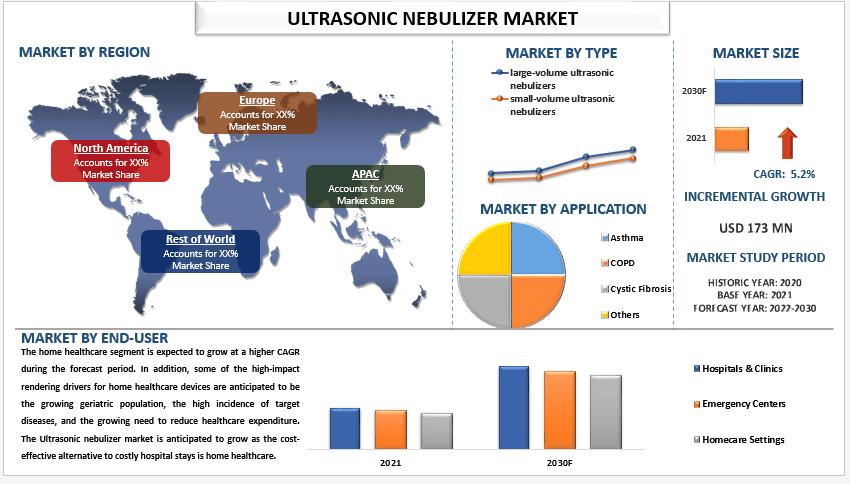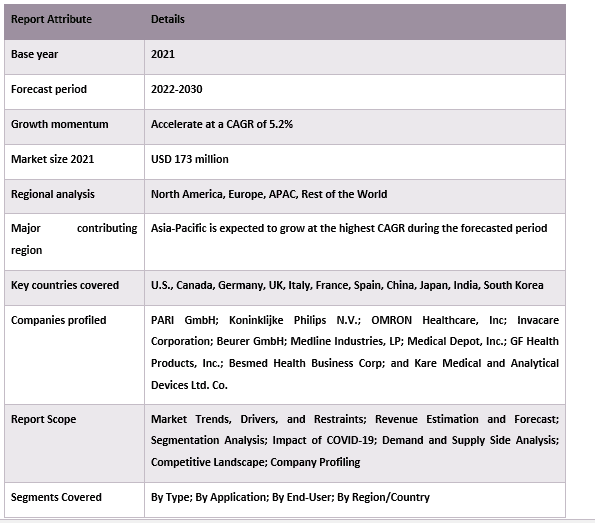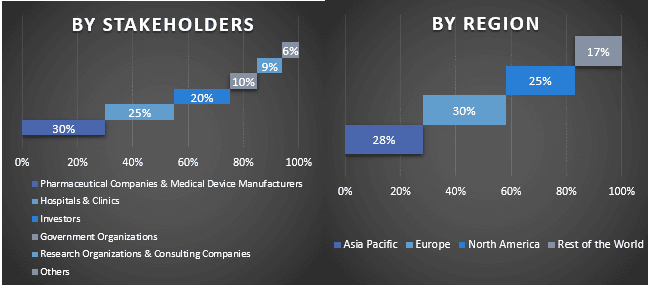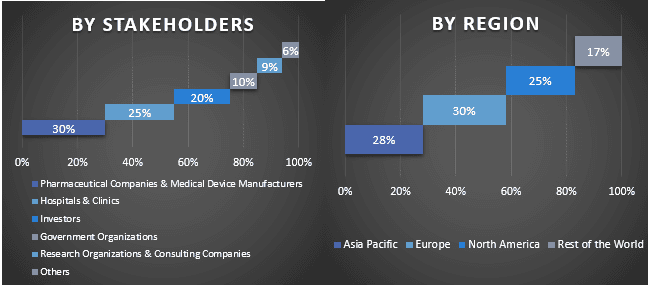Emphasis on Type (Large-Volume Ultrasonic Nebulizers and Small-Volume Ultrasonic Nebulizers); Application (Chronic Obstructive Pulmonary Disease (COPD), Cystic Fibrosis, Asthma, and Others); End-User (Hospitals & Clinics, Emergency Centers, and Home Healthcare); and Region/Country

The ultrasonic nebulizer market was valued at USD 173 Million and is expected to grow at a strong CAGR of 5.2% during the forecast period (2022-2030). Nebulizers are medical devices that are used to deliver medications in the form of mist from liquid form into the lungs. An ultrasonic nebulizer uses ultrasound waves to convert medication into mist form. The increased incidences of infectious diseases among children and their effect on the respiratory system are among the main reasons that are responsible for the market growth of ultrasonic nebulizers. For instance, according to UNICEF, globally, pneumonia occurs in more than 1,400 cases per 100,000 children, or 1 in 71 children, with the highest incidence in South Asia, West and Central Africa.
Some of the major players operating in the market PARI GmbH; Koninklijke Philips N.V.; OMRON Healthcare, Inc; Invacare Corporation; Beurer GmbH; Medline Industries, LP; Medical Depot, Inc.; GF Health Products, Inc.; Besmed Health Business Corp; and Kare Medical and Analytical Devices Ltd. Co. Several M&As along with partnerships have been undertaken by these players to facilitate customers with hi-tech and innovative products/technologies.
Insights Presented in the Report
“Amongst type, the small-volume ultrasonic nebulizers segment is expected to grow at a higher CAGR during the forecast period.”
On the basis of type, the market is segmented into large-volume ultrasonic nebulizers and small-volume ultrasonic nebulizers. As per our analysis, the small-volume ultrasonic nebulizers segment is expected to grow at a higher CAGR during the forecast period. The demand for small-volume ultrasonic nebulizers is the increasing prevalence of respiratory diseases worldwide. According to the World Health Organization (WHO), over 339 million people suffer from asthma, and COPD is the third leading cause of death globally. As a result, there is a growing need for efficient and convenient drug delivery systems, leading to the adoption of small-volume ultrasonic nebulizers. The compact size and portability of small-volume ultrasonic nebulizers make them highly desirable for patients who require regular and on-the-go medication administration.
“Amongst applications, the asthma segment held the dominant share in 2021.”
On the basis of application, the market is segmented into chronic obstructive pulmonary disease (COPD), cystic fibrosis, asthma, and others. asthma segment held the dominant share in 2021. The presence of large number of asthma cases globally is the major reason for the large share of the segment in the ultrasonic nebulizer market. For instance, according to the World Health Organization, Asthma affected an estimated 262 million people in 2019 and caused 455 000 deaths.
Ultrasonic Nebulizer Market Report Coverage

“Amongst end-users, the home healthcare segment is expected to grow at a higher CAGR during the forecast period.”
On the basis of end-user, the market is segmented into hospitals & clinics, emergency centers, and home healthcare. As per our analysis, the home healthcare segment is expected to grow at a higher CAGR during the forecast period. In addition, some of the high-impact rendering drivers for home healthcare devices are anticipated to be the growing geriatric population, the high incidence of target diseases, and the growing need to reduce healthcare expenditure. The Ultrasonic nebulizer market is anticipated to grow as the cost-effective alternative to costly hospital stays is home healthcare.
“Asia Pacific is expected to grow with the highest CAGR Ultrasonic Nebulizer market during the forecast period.”
Asia Pacific is expected to grow with the highest CAGR ultrasonic nebulizer market during the forecast period due to its large population and the increasing geriatric population in the region attributed to the market growth in the region. For instance, as per the European Parliament, Japan is aging rapidly. Its “aging” society is the oldest in the world, 28.7% of the population is over the age of 65 and women make up the majority.
Reasons to buy this report:
Customization Options:
The global ultrasonic nebulizer market can further be customized as per the requirement or any other market segment. Besides this, UMI understands that you may have your own business needs, hence feel free to connect with us to get a report that completely suits your requirements.
1. Market Introduction
2. Research Methodology Or Assumption
3. Market Synopsis
4. Executive Summary
5. Global Ultrasonic Nebulizer Market Covid-19 Impact
6. Global Ultrasonic Nebulizer Market Revenue, 2020-2028f
7. Market Insights By Type
8. Market Insights By Applications
9. Market Insights By End-user
10. Market Insights By Region
11. Ultrasonic Nebulizer Market Dynamics
12. Ultrasonic Nebulizer Market Opportunities
13. Ultrasonic Nebulizer Market Trends
14. Demand And Supply-side Analysis
15. Value Chain Analysis
16. Pricing Analysis
17. Competitive Scenario
18. Company Profiled
19. Disclaimer
Research Methodology for the Ultrasonic Nebulizer Market Analysis (2022-2030)
Analyzing the historical market, estimating the current market, and forecasting the future market of the global ultrasonic nebulizer market were the three major steps undertaken to create and analyze the adoption of ultrasonic nebulizers in major regions globally. Exhaustive secondary research was conducted to collect the historical market numbers and estimate the current market size. Secondly, to validate these insights, numerous findings and assumptions were taken into consideration. Moreover, exhaustive primary interviews were also conducted, with industry experts across the value chain of global ultrasonic nebulizer market. Post assumption and validation of market numbers through primary interviews, we employed a top-down/bottom-up approach to forecasting the complete market size. Thereafter, market breakdown and data triangulation methods were adopted to estimate and analyze the market size of segments and sub-segments of the industry pertains to. Detailed methodology is explained below:
Analysis of Historical Market Size
Step 1: In-Depth Study of Secondary Sources:
Detail secondary study was conducted to obtain the historical market size of the ultrasonic nebulizer market through company internal sources such as annual reports & financial statements, performance presentations, press releases, etc., and external sources including journals, news & articles, government publications, competitor publications, sector reports, third-party database, and other credible publications.
Step 2: Market Segmentation:
After obtaining the historical market size of the ultrasonic nebulizer market, we conducted a detailed secondary analysis to gather historical market insights and share for different segments & sub-segments for major regions. Major segments are included in the report as type, application, and end-user. Further country-level analyses were conducted to evaluate the overall adoption of testing models in that region.
Step 3: Factor Analysis:
After acquiring the historical market size of different segments and sub-segments, we conducted a detailed factor analysis to estimate the current market size of the Ultrasonic Nebulizer market. Further, we conducted factor analysis using dependent and independent variables such as type, application, and end-user of the ultrasonic nebulizer market. A thorough analysis was conducted for demand and supply-side scenarios considering top partnerships, mergers and acquisitions, business expansion, and product launches in the ultrasonic nebulizer market sector across the globe.
Current Market Size Estimate & Forecast
Current Market Sizing: Based on actionable insights from the above 3 steps, we arrived at the current market size, key players in the global ultrasonic nebulizer market, and market shares of the segments. All the required percentage shares split, and market breakdowns were determined using the above-mentioned secondary approach and were verified through primary interviews.
Estimation & Forecasting: For market estimation and forecast, weights were assigned to different factors including drivers & trends, restraints, and opportunities available for the stakeholders. After analyzing these factors, relevant forecasting techniques i.e., the top-down/bottom-up approach were applied to arrive at the market forecast for 2030 for different segments and sub-segments across the major markets globally. The research methodology adopted to estimate the market size encompasses:
Market Size and Share Validation
Primary Research: In-depth interviews were conducted with the Key Opinion Leaders (KOLs) including Top Level Executives (CXO/VPs, Sales Head, Marketing Head, Operational Head, Regional Head, Country Head, etc.) across major regions. Primary research findings were then summarized, and statistical analysis was performed to prove the stated hypothesis. Inputs from primary research were consolidated with secondary findings, hence turning information into actionable insights.
Split of Primary Participants in Different Regions

Market Engineering
The data triangulation technique was employed to complete the overall market estimation and to arrive at precise statistical numbers for each segment and sub-segment of the global Ultrasonic Nebulizer market. data was split into several segments & sub-segments post studying various parameters and trends in the areas of the type, application, and end-user in the global ultrasonic nebulizer market.
The main objective of the Global Ultrasonic Nebulizer Market Study
The current & future market trends of the global ultrasonic nebulizer market were pinpointed in the study. Investors can gain strategic insights to base their discretion for investments on the qualitative and quantitative analysis performed in the study. Current and future market trends determined the overall attractiveness of the market at a regional level, providing a platform for the industrial participant to exploit the untapped market to benefit from a first-mover advantage. Other quantitative goals of the studies include:

Customers who bought this item also bought